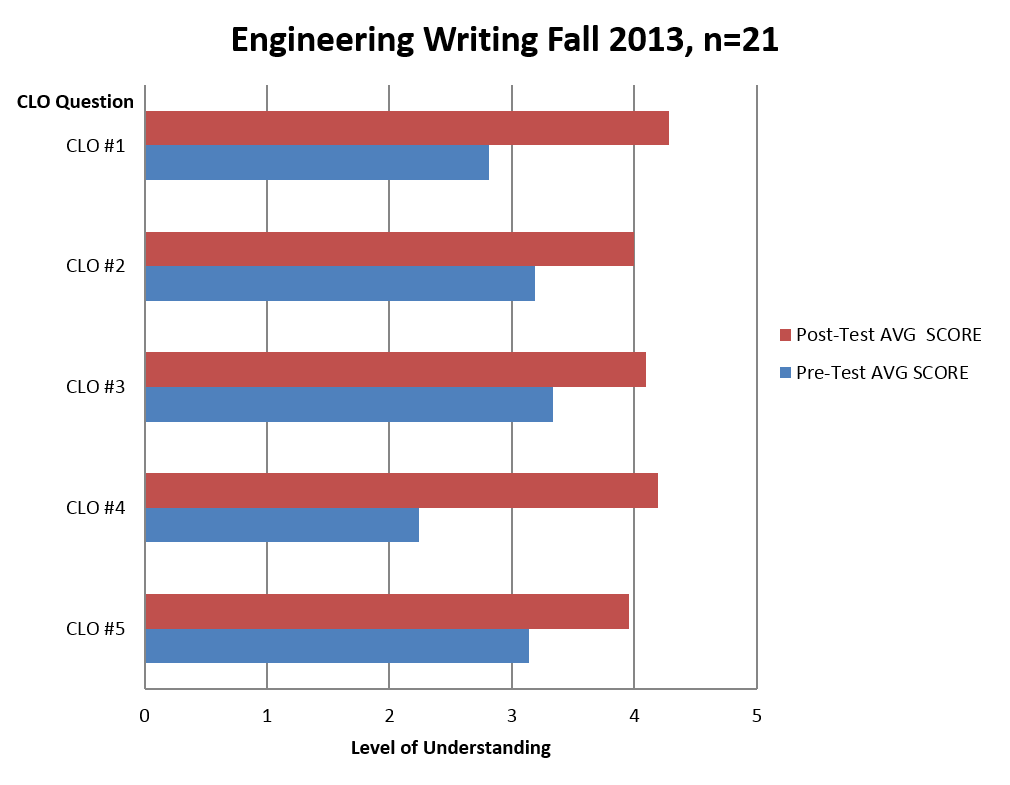Improving Engineering Writing Outcomes
Improving Engineering Writing Outcomes
EME 150A - Mechanical Design; EME 107A -Experimental Methods
UWP 102E - Engineering Writing
Mike Hill and Brad Henderson teamed up to address the challenge of improving engineering writing outcomes in three upper-division courses. Hill saw an opportunity to improve students' ability to produce clearly written, professional quality, industry-specific documents in his upper division engineering courses, and better align the complementary writing program class with engineering students' needs. Henderson and Hill received an ASK grant to assess student learning and identify ways to improve writing outcomes in courses taught both in the Mechanical Engineering Department and the UWP. Beginning with Program Learning outcomes for Mechanical Engineering, they identified sets of Course and Assignment Learning Outcomes for the targeted classes.
For more information click here.
Step 1. Defined Course Learning Outcomes (CLOs)
In collaboration with the Assessment Coordinator, Henderson defined Course Learning Outcomes for UWPf 102E (Engineering Writing):
- Knows why engineering communication is important.
- Can assess audiences and aim messages.
- Can write concise, clear and correct sentences.
- Can identify discipline-specific document structures.
- Can deliver effective oral presentations.
Step 2. Assessment
Hill and Henderson undertook three levels of assessment, based on the evaluation levels identified by Donald Kirkpatrick, Professor Emeritus at University of Wisconsin's Management Institution:
- Reaction: self-reported change in competence.
- Learning: Measurement of ability to identify common errors in engineering writing.
- Behavior: Holistic review of student writing samples before and after delivery of learning modules, measuring the extent to which students apply learning.
Level 1 Assessment: Self-Reported Change in Competence
Henderson's students were asked to rate their abilities for each of the five course-level student learning outcomes on a 1-5 scale.
The pre- and post-course self-assessments were administered via SmartSite to facilitate distribution.
Students reported increases in each of the learning outcomes, with the strongest gain in CLO #2 "Can assess audiences and aim messages" (Figure 1).


CLO #3: Can write concise, clear and correct sentences
Assignment LO: Can identify common sentence errors.
Precision is essential in engineering writing. In 102E, Henderson administered pre- and post-tests asking students to identify 20 errors embedded in a selection of engineering writing, based on the seminal research of Stanford professor Andrea Lunsford on the most common errors made in college-level writing. Results identified improvement in all but one category, with 91% improvement in identifying lack of pronoun-antecedent agreement (Figure 2).
A Solution to Explore: JIT Modules
In this pilot phase, students responded well to JIT instructional modules threaded into engineering classes. When modules were integrated into the teaching plan, less time overall was spent on improving student's writing, while outcomes improved. The instructors believe it is possible that auxiliary writing classes such as UWP 102E might be effectively replaced by fully intergating discipline-specific writing instruction into engineering design and lab series classes.
Henderson's paper presented at the 2014 ASEE national conference
![]()
Results
- Articulating CLOs sharpened the teaching focus: each assignment was deliberately linked to measuarble improvement in CLOs. Students in turn became more accountable for their learning. In each case, writing was measurably improved.
- CLO-based rubrics streamlined and normalized grading. Projects TAs reported achieving more accurate and consistent paper grading outcomes using project's new rubrics. Rubrics reduced paper grading time for engineering TAs and faculty.
- TAs noted that the project improved their own skill-level.
Plan
Henderson and Hill collected results over two quarters in AY 2013-14. Initial success of this pilot trial has yielded plans for a more rigorous assessment with a larger sample size. Future plans include:
- Continuing collaboration on front-end design and testing of outcome-driven writing instruction and evaluation for engineering students, particularly those majoring in mechanical engineering.
- Continuing to refine and optimize threaded JIT modules on applied engineering writing and discipline-specific report forms for engineering design classes and lab classes.
- Charter UWP's WAC team with the continuation task of collecting and analyzing more samples of student work in engineering classes, and with assisting engineering faculty with further development of CLO-driven grading rubrics, assignment writing guidelines, and paper grading guidelines, in order to achieve statistically significant results.